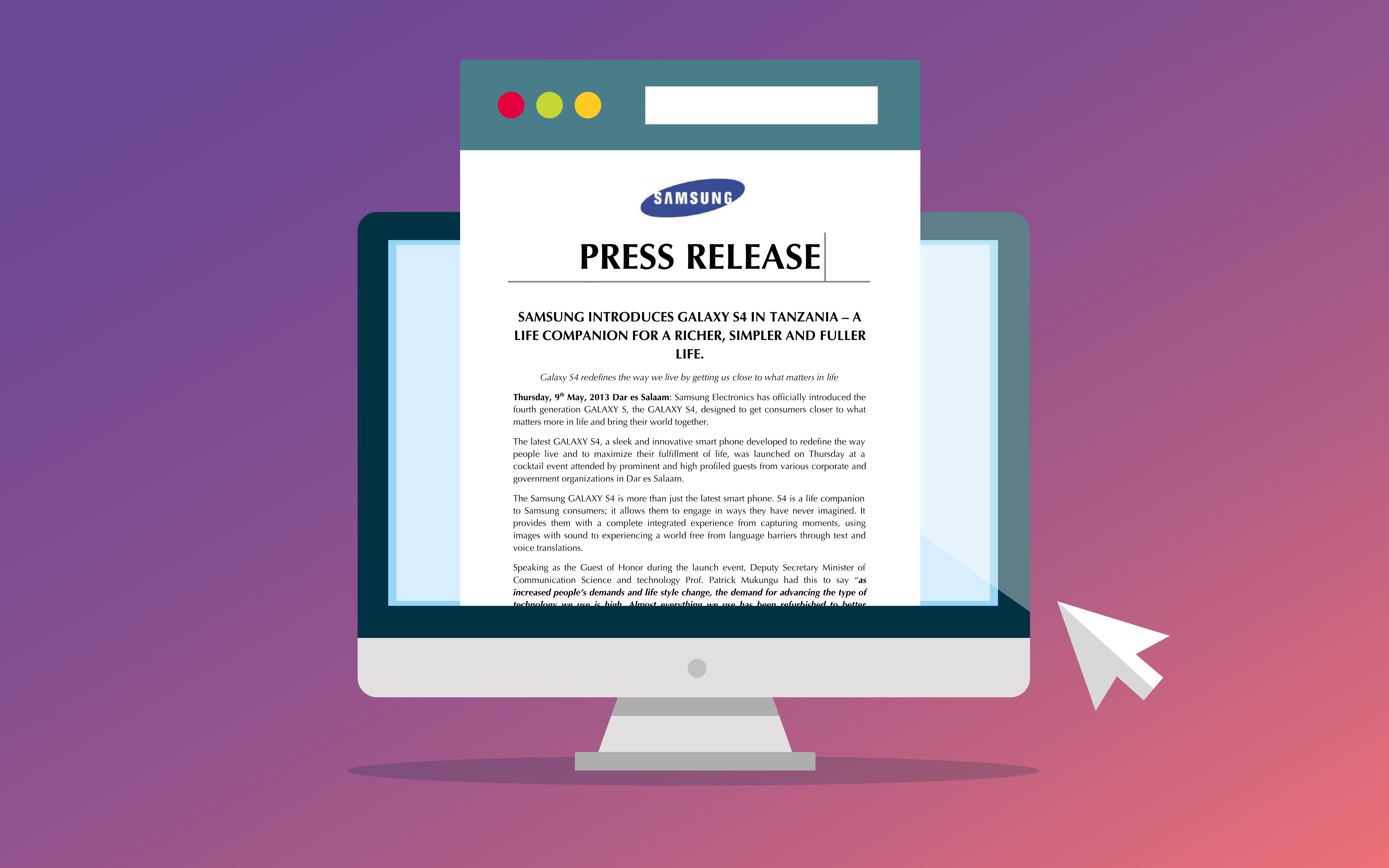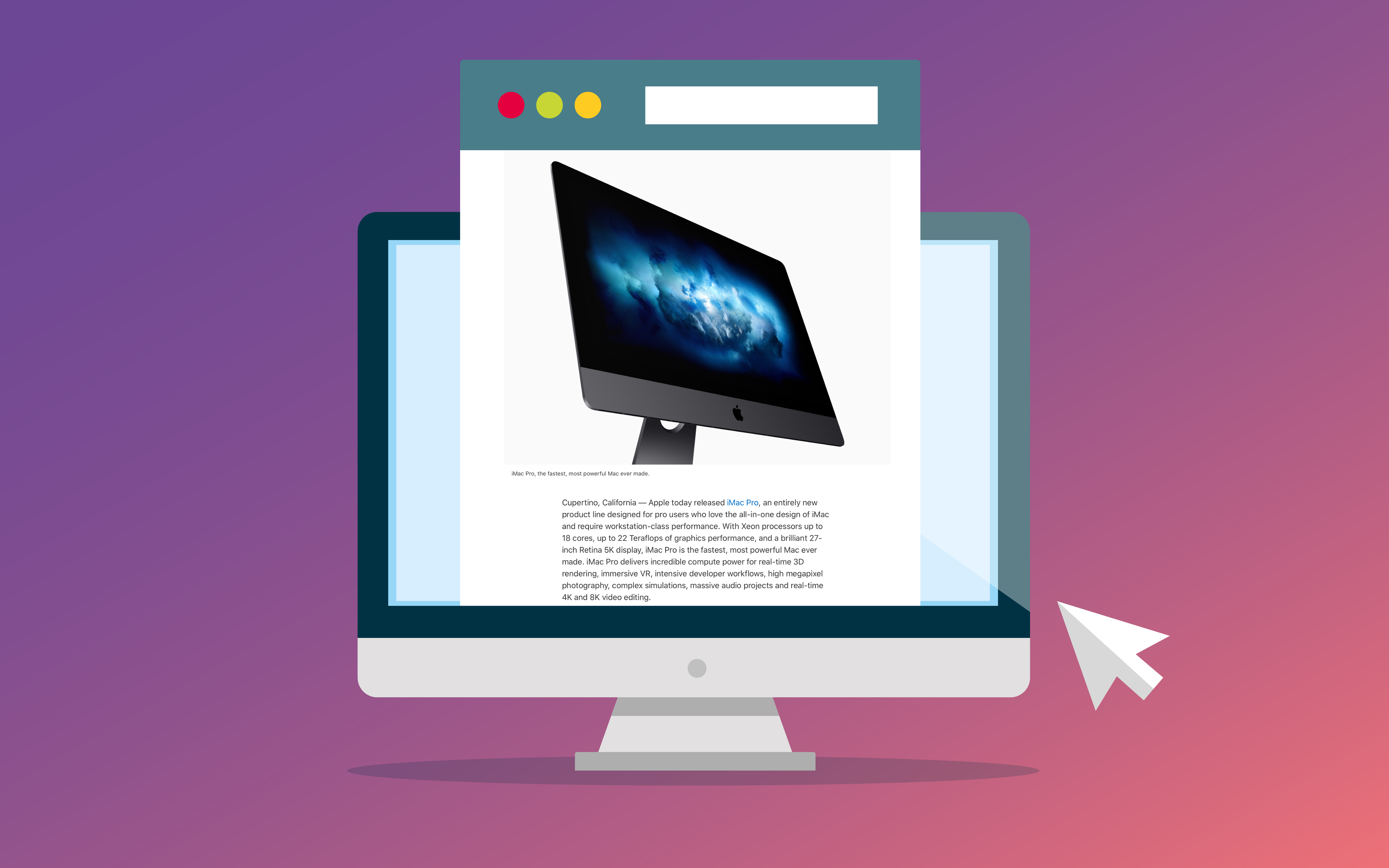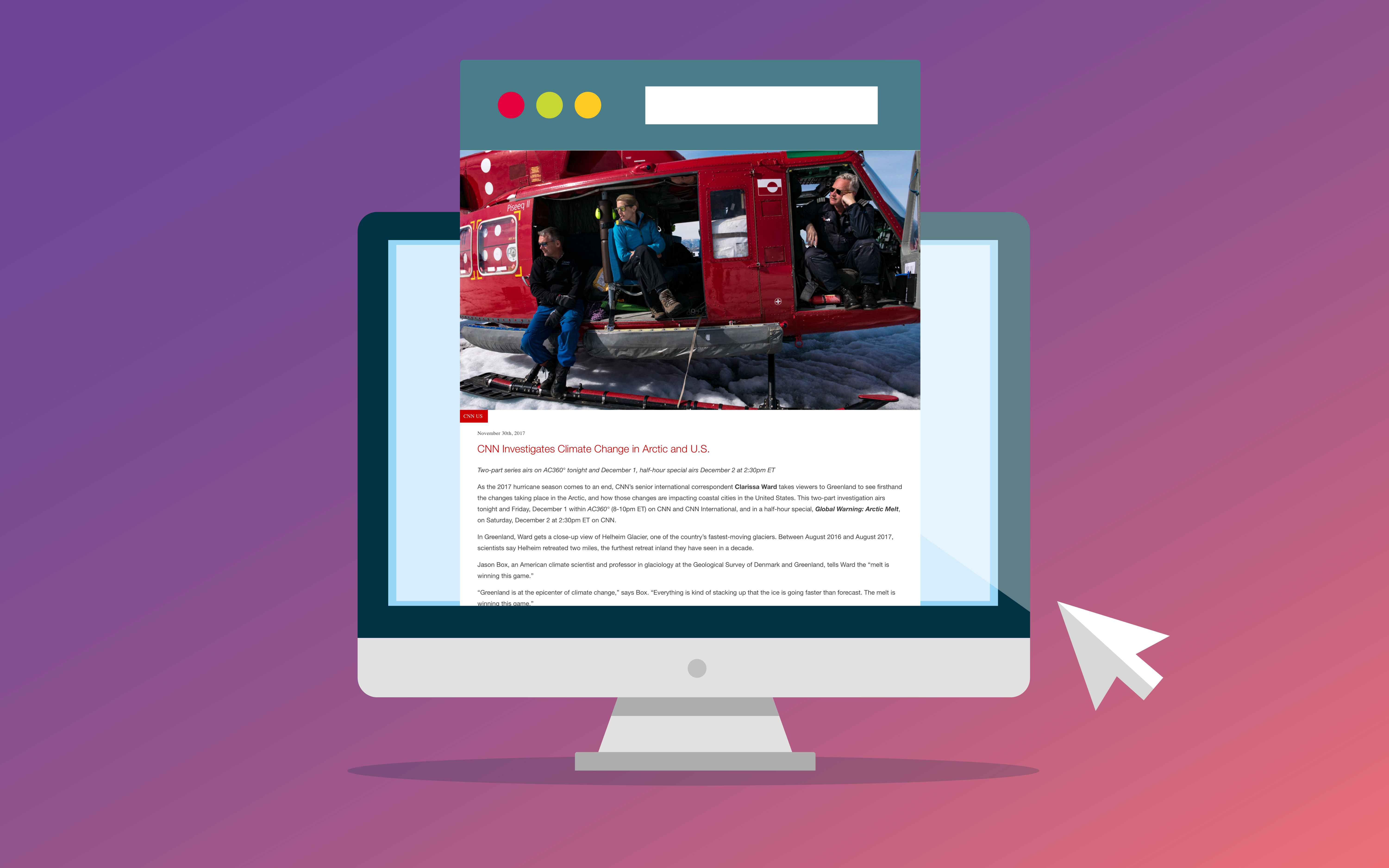How to write a press release: Your guide to working with the media

Sometimes, we get so caught up with the latest parts of the content marketing world, that we forget that a considerable part of building your brand’s reputation, still depends on how well you can network.
To get the best results from your content marketing, you need to make sure that your blogs, videos, and podcasts aren’t just reaching your target audience – but the media too.
Over the years, the way that companies capture the attention of media publications have changed. You won’t need to send a letter via snail mail to the most prominent newspapers in your area anymore (unless you want to). Instead, you’ll be looking to capture media attention online through social media, industry forums, and more. While the methods you use to connect with journalists and other industry hype-generators are changing, the tools you access are mostly the same.
For instance, you’re still going to need a stable press release if you want as many people as possible to learn about what’s going on with your company.
Today, we’re going to introduce you to the basics of how to write a press release, the standard press release format, and why it’s so important to get your PR strategy under wraps.
Let’s get started.

What makes a proper press release? Intro to PR content
Content is one of the most valuable tools in a modern company’s arsenal.
The more you provide your customers with information about your business, the easier it is for them to build a relationship with your brand.
Just as a regular stream of blog posts and videos helps businesses to create a strong relationship with customers over time, a consistent collection of important news helps companies to build mindshare with journalists. This means that relevant publications start to pick up on the little things that your company does, giving you more opportunities for brand awareness in the future.
A press release is an official announcement, either recorded or written that your company can issue to news publications and journalists. Whether you call it a press statement, press release, news release, or something else entirely, you’re almost always talking about the same thing.
Used as a valuable part of a brand recognition strategy, press releases are often short and concise. They’re designed to get customers, partners, and other companies interested in what you’re doing. What’s more, these content-based tools also help to highlight your position as a brand and show your customers that you share their values. Although there’s no carved-in-stone formula for what a press release needs to cover, here are some of the occasions that might convince you to start writing a press release for your business:
- New product launch
- Acquisition or merger
- Updates to an existing product in your portfolio
- Opening a new office or moving to a new location
- Rebranding, or refreshing your brand
- Hiring a new executive for your team
- Receiving an award
- Doing something for the community, or contributing to charity

Why is writing a press release a good idea?
As you’ll see in our press release guidelines below, writing the perfect announcement for the media isn’t always easy. Although the experience gets more straightforward as you develop your writing skills, you might be wondering why you should bother with press releases in the first place?
A great press release is more than just a way to differentiate yourself from your competitors and capture the attention of the press. When used properly, these tools can provide several fantastic benefits. For instance, they’re effective and cost-efficient tools for spreading brand reach. Since releasees are published online and shared on social media, there’s a lot of opportunities to attract prospective customers and backlinks.
Crucially, a well-written press release also helps you to gain more control over the story shared for your brand. You can share what’s crucial to you and call more attention to the value that you have to offer. In the case of a crisis, where your brand reputation comes into question, you can even use a press release to respond to a story quickly and strategically.
Knowing how to send out a press release to the right distribution centres after its written also improves your potential for stronger SEO. You might even keep a record of your latest press releases on a “news” page for your website.
Press releases:
- Drive more traffic to your website
- Strengthen your brand reach
- Improve your Google ranking
- Boost your company’s trust and credibility
- Give you more control over your brand reputation
Learning how to write a press release won’t instantly get your business featured on the front cover of Forbes magazine, but it will help your company to get the attention it deserves.

Press release template: Your press release format guide
Okay, so now you know that a press release is a brief document sharing useful news about your business with the media outlets. So, what makes a good press release, and how do you write a press release that speaks to the right journalists?
Well, as with any content strategy, it’s essential to make your announcements stand out from your competition. However, press releases do generally follow a standard set of guidelines that you need to keep in mind. If you track the typical press release format, then you’re more likely to get published.
Start by writing a press release email to the journals and publications that you want to show up in. Make it clear to reporters, editors, and writers, that you’re giving them content for them to use. If you don’t want the information to be released immediately, you can request an “Embargo” until a certain date. In the press release itself, follow these structural tips:
- Start with the words “Media Contact” in the upper corner of the page, with an email address, phone number, and name for a person to contact with follow-up questions.
- Include the date on which the information can be made public underneath your Media Contact details. It’s essential to keep this information at the top of your press release structure.
- At the left of the page, or in the centre, include a headline summarizing what you cover in the press release. For instance: “YourBrand Named Top Marketing Tool for 2020”. Some companies include a little extra information after this on the next line too.
- On the next line, start writing your press release with information on the city and state you’re in. Format this in capital letters. For instance: “AUSTIN, TEXAS – October 12th, 2019”.
- Start your announcement and write in an inverted pyramid style. This means that you put the most important information for your announcement in the top line, with the next most crucial info second, and so on. If an editor needs to cut material from your release, an inverted pyramid will ensure that the most important details get into the story.
- Double-space all of your paragraphs for clarity.
- End with the ### symbols in the bottom centre of your page.
Following the right press release guidelines
Now that you know the basics of how to write a press release, and the structure it needs to follow, you’ll be ready to start writing a release that speaks to both your audience and the necessary publications.
The more you use press releases as part of your digital marketing strategy, the more you’ll learn about how companies and people respond to your content. However, while you’re just getting started, keep the following press release guidelines in mind.
1. Always find an engaging and newsworthy angle
The first thing to remember when you’re learning how to write a great press release is that you’re not just writing any old content. A press release is an official document that’s supposed to act as an important announcement or piece of news. Since you’re appealing specifically to journalists, you’ll need to think carefully about what the publications in your industry will deem to be “newsworthy.”
Before you start writing a press release about anything, ask yourself whether there’s value in your chosen story. Will journalists want to share your content, and will the end-users that read that story see the value in it?
Look at this press release from Coca-Cola for instance; it highlighted Cola’s win of two national awards for health and environmental leadership. This allowed the company to build higher affinity with an audience that had questioned the health effects of cola in the past.

This story is valuable not just for Coca-Cola’s reputation, but also for journalists who know that the health and safety of fizzy drinks is a crucial concern for many consumers.
2. Make sure that you know your audience
Just like with any piece of useful content, a press release should always be written with your target audience in mind. However, remember that as well as appealing to your standard content, you need to know how to send out a press release that speaks to journalists and editors too.
Write a fitting headline and plenty of interesting copy that your preferred media outlets are sure to see value in. It’s also worth noting that in today’s social world, press releases may be shard in many different ways. Alongside people sharing links to your stories, you might also get a lot of people who simply share a meaningful quote from your latest release on Facebook or Instagram.
With the needs of your media audience in mind, tailor your press release to be as concise and easy to promote as possible.
3. Know the “W’s” for your press release
Finally, when you’re wondering what to include in a press release, it’s worth noting that the editors of a press release often edit from the bottom up. That’s why, in our tips on press release structure, we recommended including the most critical information at the top of the page.
One way to ensure that you’ve addressed all of the most essential points include covering the “W’s” in your press release. This means looking at:
- Who: Who does your news reflect, and who will it benefit?
- What: What is the news based on? What are you going to cover?
- When: When exactly did this happen, is there any significance to the timing?
- Where: Where did the event happen, and where is your business located?
- Why: Why do people need to know about this information? What are the benefits?
The answers to all of these questions need to be covered within the opening paragraph of your press release. Take a look at how Samsung addresses all the W’s instantly within the initial words of its press release below:

3 quick press release examples for announcement inspiration
If you’re still feeling a little uncertain about using press release content in your external communication strategy, don’t worry. Like any promotional effort, a press release is something that can take time to get used to. Once you’ve come to terms with the basic press release format, and you’ve got the hang of pinpointing great news stories to cover, you’ll find that the process feels a lot easier.
In the meantime, if you’re stuck with writer’s block, and you’re not sure how to start earning the attention of the right journalists, the following press release examples might help.
1. Apple’s product launch press release
This is a basic example of a product news press release from Apple. The most important information is covered right off the bat “Apple today released iMac Pro,” and there’s plenty of useful data scattered throughout the body of the content.
Apple also added a little more depth to their press release format by including some quotes from the VP of Hardware engineering for the brand, a few images too.

Apple is excellent at highlighting the key features of the product in this press release, and they go into detail so that journalists can decide for themselves which key points they want to cover.
2. CNN’s news press release
This breaking-news style press release from CNN gets straight to the point with a title that explains what the statement needs to cover “Climate change in arctic and US.” As you get further into the version, there’s plenty of in-depth information available, as well as useful quotes to give more credibility to the story.

CNN keeps its story short and concise, with quick and snappy information that’s perfect for sharing. Additionally, the press release covers crucial data about when the event will begin and end, and what might happen during the night.
3. Hormel Institute research press release
Finally, this press release example from the Hormel Institute highlights a critical finding in the organisation’s research. The title explains what was discovered “Wilms’ Tumor breakthrough,” and there’s information about the main researchers at the top of the page too.
The press release explains the background of the research and where it began, and it also draws attention to the benefits that this latest finding has to offer.

How do you write a press release that makes an impact?
Even with an fantastic newsworthy story to cover, there’s no guarantee that every publication will instantly pick up your press release.
Keep in mind that there are countless brands just like you, looking for ways to boost their awareness through collaborations with the right media outlets. Although you can’t always guarantee that your press release will make the right impact, you can learn how to write a press release and distribute it in a way that’s more likely to be successful.
For instance, here are some of the tips you can use when figuring out how to write a great press release that speaks to your audience.
1. Create an incredible headline
Just like when you’re writing a blog post, and you need a fantastic headline to capture your audience’s attention, the same rules apply for your press release. Make sure your headline stands out with action verbs and understandable language. Additionally, make sure that you keep your announcement headline as quick and simple as possible.
For instance “YourBrand Wins Award for Customer Service” is much better than ” YourName wins first customer service award after nomination in July.” Above all else, keep the title interesting. Remember that these reporters are getting hundreds of releases each day, yours needs to stand out.
2. Highlight the value in your news
For reporters and influencers to actually share your announcement, you’re going to have to convince them that your news is worth their time. Make sure that the first paragraph of your announcement covers plenty of essential information that excites your reader and encourages them to share.
After the first paragraph, you can get down into the extra details of your announcement, such as what led to the event, or how you’ve evolved over the years to achieve this new accomplishment. However, the most valuable data shouldn’t be any further down than the first paragraph.
3. Offer a tempting quote
Once you’ve set the scene for your news story, remember to bring the details to life with a quote or two from a relevant official in your team. This will help to give reporters more context for your announcement. Ideally, the quotes will come from stakeholders in your company, like your executive team. Quoting prominent figures and authorities gives more value to your announcement.
Additionally, remember that the chosen quotes in your press release should emphasize the core of the announcement. Don’t ask everyone in your office for a comment, just pick one or two critical spokespeople.
4. Include a boilerplate
Finally, social media is full of reporters that are constantly complaining about press releases and pitches that don’t explain what the company does or what the announcement is really about. Describing what your company does and who was involved in the latest report with a boilerplate message is always a good idea.
If you cite any details from other companies, make sure that you include a reference link for the data source, and make sure every name has an associated title. It’s also worth asking someone to read through the press release before you start sending it out to check that everything makes sense and that you’ve covered the critical information.

Mastering the press release basics
While knowing how to write a great press release doesn’t necessarily guarantee coverage by the right publications, it is a valuable marketing tool. Sending out regular press releases allows you to build up brand recognition with media groups. The relationship that you build with these outlets may be valuable in the future too, particularly when journalists are looking for a thought leader to quote.
Remember, achieving successful publicity in your industry means making a sustained effort to connect with the right people and groups.
If you ever do get coverage for your press release, be sure to keep the buzz going by sharing your stories on social media and asking influencers to give you a boost. You’d be surprised how quickly your reputation grows.
If you enjoyed this article, you might enjoy these too:
— How to conduct an external marketing audit
— Lost in translation: The dangers of jargon











